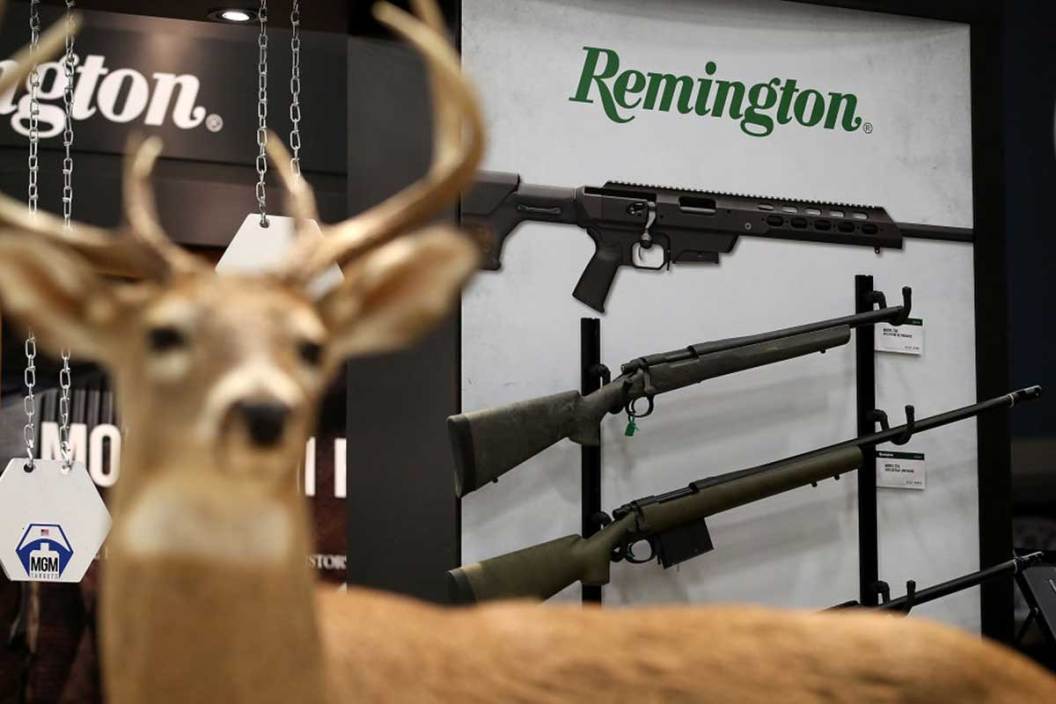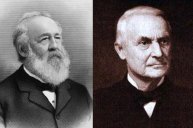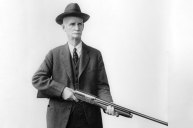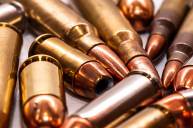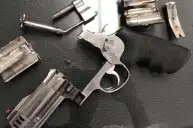These gunmakers are as famous as their firearms.
These gunmakers have contributed more to the worldwide gun industry than any other, some for decades on end.
Here are some of the most prolific gun companies and their stories.
Colt
Officially called Colt's Manufacturing Company, this American firearms manufacturer was founded in 1855 by Samuel Colt. He is known for engineering, producing, and marketing some of the first successful and mass produced revolvers in history, and some of the best selling models at that.
The company's earliest designs played a major role in making revolvers common and popular. Colt's wheelguns were the first successful and affordable guns of their kind, and the first with interchangeable parts. The intial viable gun from Colt was the Colt Walker revolver. The most famous is undoubtedly the Single Action Army, aka the Colt Peacemaker.
Colt was the first company to manufacture the military's M1911 pistol beginning in WWI. The pistol was in service until 1985. On the military side, Colt manufactured the M16 rifle and the M4 carbine for many years. The Colt Python in .357 Magnum is widely regarded as one of the finest modern revolvers ever produced.
In 2002, Colt Defense split from the main company, but the company was reformed as one when it lost the M4 contract in 2013. It filed for bankruptcy and emerged from Chapter 11 status in 2016. In 2021, Colt was purchased by the Czech gunmaker ?eská Zbrojovka Group (CZ).
Glock
The official name of this Austrian gun company is Glock Ges.m.b.H., with its HQ in Deutsch-Wagram, Austria. It's named after its founder, Gaston Glock, and is best known for its extremely popular line of polymer-framed handguns.
Glock pistols are used by law enforcement agencies and militaries around the world, including a majority of law enforcement units in the U.S. Glocks are also extremely popular with civilians for self-defense and competition shooting. While Glock offers their handguns in a number of sizes, configurations, and chamberings, there is also a bustling aftermarket for Glock parts that allow owners to customize their handguns in pretty much any way they desire.
Oddly enough, Gaston Glock had no firearm experience when the company was prototyping its first gun, the Glock 17, but he knew a lot about cutting edge polymers. That allowed him to offer valuable insight that helped create the first commercially successful handgun that used a polymer frame. Glock also introduced a new anti-corrosion coating to the firearms industry known as ferritic nitrocarburizing.
Glock got its start when the Austrian Armed Forces announced it wanted a new duty pistol in 1980 to replace its aging World War II-era Walther P38 handguns. In response, Glock formed a team of leading European handgun experts in 1982 to define the most important characteristics of a combat handgun and developed a working prototype from that feedback.
The company's first pistol went up against some stiff competition when competing for the Austrian military and police handgun contract in '82, including guns from Heckler & Koch in Germany, SIG Sauer in Switzerland, Beretta of Italy, and FN Herstal of Belgium, which submitted an updated version of the Browning Hi-Power pistol, and Steyr Mannlicher. The prototype P80 came out on top, and became the Glock 17.
The Glock 17 was so named because it was the 17th patent filed by the company—the fact that the magazine holds 17 9mm rounds was a happy accident. The handgun quickly gained a reputation for being a little nondescript and maybe even a little ugly, but also for being extremely durable and comfortable to carry and shoot. It stood up to multiple endurance tests of all kinds.
After 1988 and after surpassing all durability standard tests, the G17 became the standard NATO sidearm. By 1992, more than 350,000 Glocks had been sold worldwide, including 250,000 in the U.S. alone.
In 2013, the largely unchanged Glock 17 again beat out handgun entries from gunmakers like SIG Sauer, Smith & Wesson, H&K, FN, Beretta, and Steyr for the British Armed Forces contract. They finally replaced their aging Browning Hi-Power pistols with the Glock 17 Gen4 handgun. In 2020, the French military adopted the Glock 17 Gen5.
Remington Arms Company
At one time, Remington was the largest long gun manufacturer in North America. The company was founded by Eliphalet Remington in 1816 as E. Remington and Sons in Illion, New York. That also makes it one of the oldest gunmaker in the country and before it shut down, it was the oldest continuously operated factory in the U.S. that still made the original product for which it was built.
On the ammunition side, Remington developed more cartridges than any gunmaker or ammo company in the world.
In rifles, its flagship model was undoubtedly the Remington 700 bolt action, and the Remington 870 is considered the best pump action shotgun ever made.
In 2014, Remington moved into a new plant in Huntsville, Alabama and planned for most of its production lines to be moved there. Early on, its AR-15 semi-automatic rifle production and handgun production was stationed there.
Four years later, in 2018, Remington filed for Chapter 11 bankruptcy after accumulating $950 million in debt. The company exited bankruptcy in 2018, but filed again in July 2020. That was the end.
The company, then known as Remington Outdoor Company, was chopped up and sold off to various buyers.
Ruger bought the Marlin Firearms brand and its extensive lines of lever action guns, while Vista Outdoor purchased the Remington Ammunition business and the Remington brand name.
The Remington Arms business was sold to Roundhill Group, LLC. JJE Capital Holdings, LLC bought the DPMS, H&R, Stormlake, AAC, and Parker brands.
In April 2021, Vista Outdoors brought Remington Ammunition production back online.
Winchester Repeating Arms
https://www.instagram.com/p/CTUpIGcnMIC/
The Winchester Repeating Arms Company was once the most famous maker of repeating long guns in the world. It produced them in New Haven, Connecticut and is responsible for creating the Model 1866 lever action rifle, later called The Gun That Won The West.
Winchester dominated the repeating rifle world and was the sole manufacturer in the U.S. of John Moses Browning's gun designs for many years.
Today, the Winchester brand is still alive, though it is owned by the Olin Corporation and the name is used under license by subsidiaries of the Herstal Group, Fabrique Nationale (FN) of Belgium and the Browning Arms Company of Ogden, Utah.
Winchester was actually born from the remnants of a gun company called the Volcanic Repeating Arms Company, formed by Horace Smith and Daniel Wesson of Norwich, Connecticut. The company was a little ahead of its time, and its repeating lever action pistol and rifle that used caseless "Rocket Ball" ammo was short lived. When the company folded and Smith and Wesson moved on, the company's largest stockholder was a clothing manufacturer named Oliver Winchester.
Winchester reorganized the failed Volcanic into the New Haven Arms Company and worked with Benjamin Henry on finishing one of Smith's projects, the self-contained metallic rimfire cartridge. He succeeded in creating the .44 Henry round, and he built the Henry rifle of 1860 to fire it. The Henry was the first commercially successful repeating rifle.
In 1866, Henry left the company over a compensation dispute and Oliver Winchester again reorganized the company into the Winchester Repeating Arms Company. He had the Henry rifle redesigned and modified through a series of prototypes and it became the Model 1866, the most successful lever gun of its day.
Through the rest of the 19th and the 20th century, Winchester produced some of the most popular repeating rifles and shotguns in the world, and introduced a number of new cartridges on the ammunition side.
After a bitter labor dispute, in 1980, the Winchester New Haven plant was sold to its employees and incorporated as the U.S. Repeating Arms Company with a license to produce Winchester firearms. The parent company, Olin, retained the Winchester ammo business.
In 1989, U.S. Repeating Arms went bankrupt and was acquired by a French holding company before being sold to Herstal Group, which owns FN and Browning Arms.
In 2006, U.S. Repeating Arms closed the legendary New Haven plant that had been in operation for 140 years. With the plants closure, production of the Model 94 rifle, the direct descendent of the Model 1866, ceased, along with the Model 70 rifle and the Model 1300 shotgun.
Later that year, Olin announced it entered into a new license agreement with Herstal subsidiary Browning to produce Winchester brand rifles and shotguns, but not in New Haven.
Today, the Model 1885, Model 1892, Model 1886, and Model 1895 lever guns are produced by Miroku Corp. in Japan and imported by Browning. FN makes the Model 70 at its pant in Columbia, South Carolina, though assembly was moved to Portugal in 2013.
In 2010, FN began producing the Model 1894 and an updated Winchester 1300 shotgun, rebranded as the Winchester SXP.
Smith & Wesson
After Smith and Wesson sold what was left of the Volcanic Repeating Arms Company to Oliver Winchester, they created a new Smith & Wesson Company in 1856, the same year Sam Colt's patent on the revolver was set to expire.
Wesson was approached by a former Colt employee, Rollin White, who had developed a cylinder that could be used with metallic cartridges, something Wesson and Smith were already working on with the Volcanic. White's invention had been brushed off by Colt, so he left the company. S&W agreed to pay White a royalty of $0.25 on every gun they produced with his cylinder. Unfortunately, this meant White, not S&W, was responsible for defending the patent in court—which ultimately bankrupted him.
The introduction of the Smith & Wesson Model 1 revolver meant S&W got to be the sole manufacturer of revolvers using mettalic cartridges for many years, delaying Colt's entry into the market as White defended his patent in court. As if that wasn't enough, poor White got slapped with a charge from the U.S. Government for causing "retardation of arms development in America."
As metallic cartridges began to replace cap-and-ball, S&W's revolvers grew more popular. Initially focusing on smaller self-defense revolvers, with the end of the Civil War, S&W switched focus to frontier revolvers with large frames and heavier calibers, like the new .44 S&W American. The result was the S&W Model 3, a top-break revolver that was adopted by the U.S. Army as the first cartridge-firing revolver ever.
An issue over ammunition supplies and the fact that the Model 3 couldn't fire the slightly longer .45 Long Colt, only .44 S&W, is the only reason the military ultimately adopted the Colt SAA in large numbers.
In 1899, S&W introduced its most popular revolver of all time, the double-action .38 Military 7 Police, aka the Model 10. It was the standard sidearm of American police officers for much of the 20th century and millions were made—1 million Model 10s were made just for the military in WWII.
Through the 20th century, S&W produced a number of extremely popular revolvers and semi-automatic handguns. Market share dropped in the 1980s when many police forces switched from wheelguns to semi-autos made by European gunmakers like Glock, Beretta, and SIG Sauer.
Today, S&W is quite popular, offering a wide array of revolvers and modern semi-auto pistols. Its updated M&P and Shield handguns have proven very popular among law enforcement and civilians for concealed carry and self defense.
Savage Arms
?Arthur Savage founded Savage Arms in 1894 in Utica, New York, about 25 minutes away from the Remington plant in Illion.
Straightaway, the company was producing rifles and handguns as well as ammunition for both. Their claim to fame was the first hammerless lever-action rifle, the Savage Model 1895, which came from the Savage Model 1892 rifle, which almost won a U.S. Army rifle contract that instead went to the Krag-Jorgensen rifle.
A .45 ACP version of Savage's striker-fired Model 1907 pistol went up against the Colt 1911 in Army handgun trials, and would be marketed in .32 ACP and .380 ACPT as self-defense pocket pistols.
During WWI, Savage merged with Driggs-Seabury Ordnance Company to produce Lewis machine guns in Sharon, Pennsylvania.
In 1920, Savage bought Stevens Arms of Massachusetts and soon after bought a bunch of buildings used for Lewis machine gun production during the war. In 1929, Savage acquired the A.H. Fox Gun Company of Philadelphia. Production of Fox guns was moved to Utica. That's how Savage became one of the few American gun makers to produce affordable double-barrel shotguns over the years, like the Fox Model B and the Stevens Model 311. Savage also produced rifles and shotguns under house brand names for companies like Sears to be sold in their stores.
During World War II, Savage again became a military arms production company. Mostly the company produced Thompson submachine guns for the military as well as British No. 4 Lee-Enfield bolt-action rifles that were sent to Britain under the Lend-Lease program.
In the late 1980s, Savage ran into some financial trouble and filed for bankruptcy, but eventually bounced back. In 2002, Savage made a big splash by offering its factory-installed, user adjustable trigger dubbed the AccuTrigger. It has become quite popular as an excellent trigger for affordable rifles. The user-adjustable AccuStock was introduced in 2009.
A conglomerate called ATK bought Savage in 2013. ATK eventually became Vista Outdoor.
While Savage had aspirations to expand and again produce Savage handguns, the company only accounted for 7 percent of Vista's business, so the company wasn't interesting in hanging on to the gun maker. In 2019, Vista sold Savage Arms and Stevens Arms to a group of investors led by Savage's management.
Today, Savage makes a number of popular rifles and shotguns, though it still has not introduced a new handgun in the 21st century.
NEXT: EVERYTHING YOU SHOULD LOOK FOR IN A GUN SAFE
